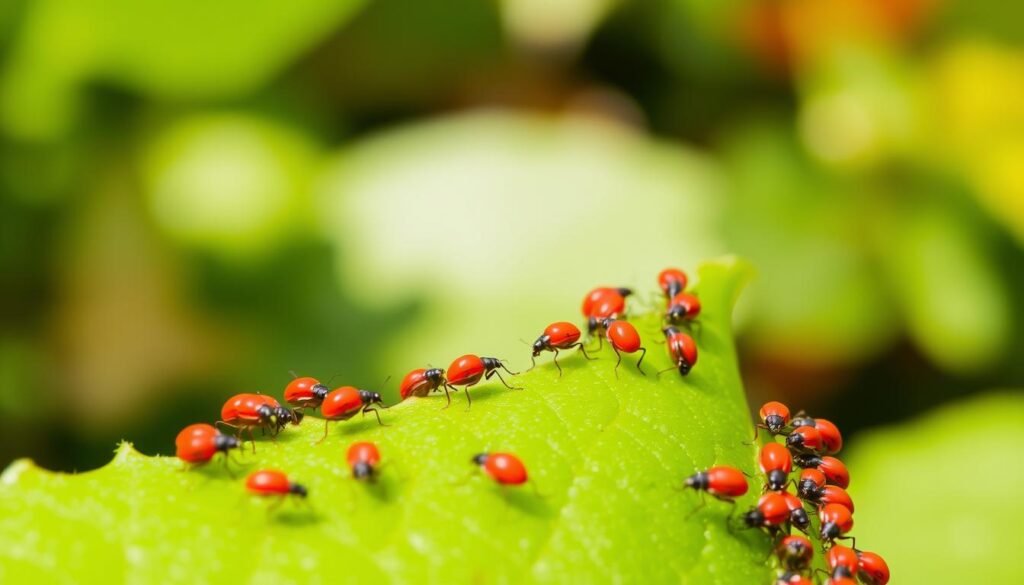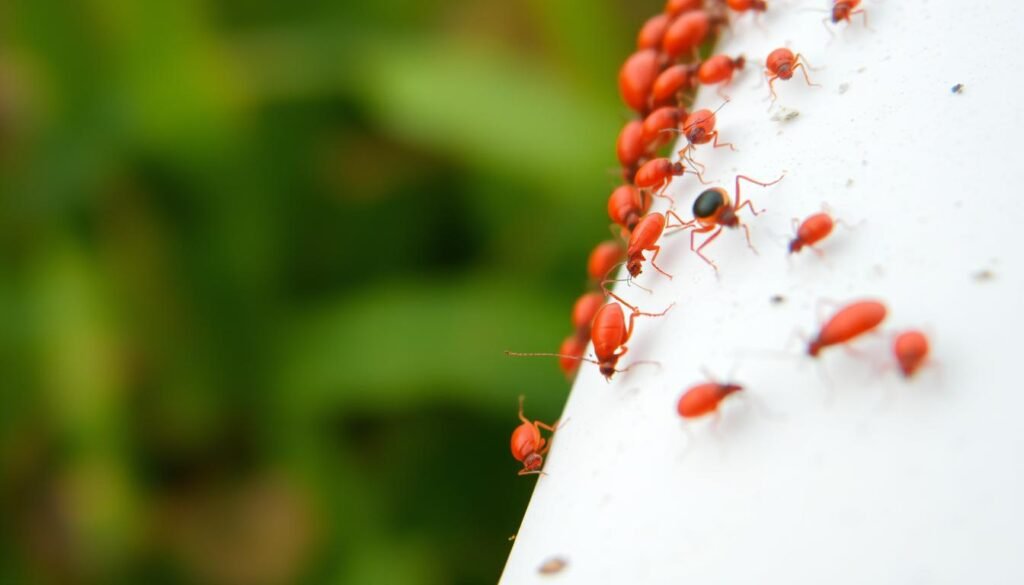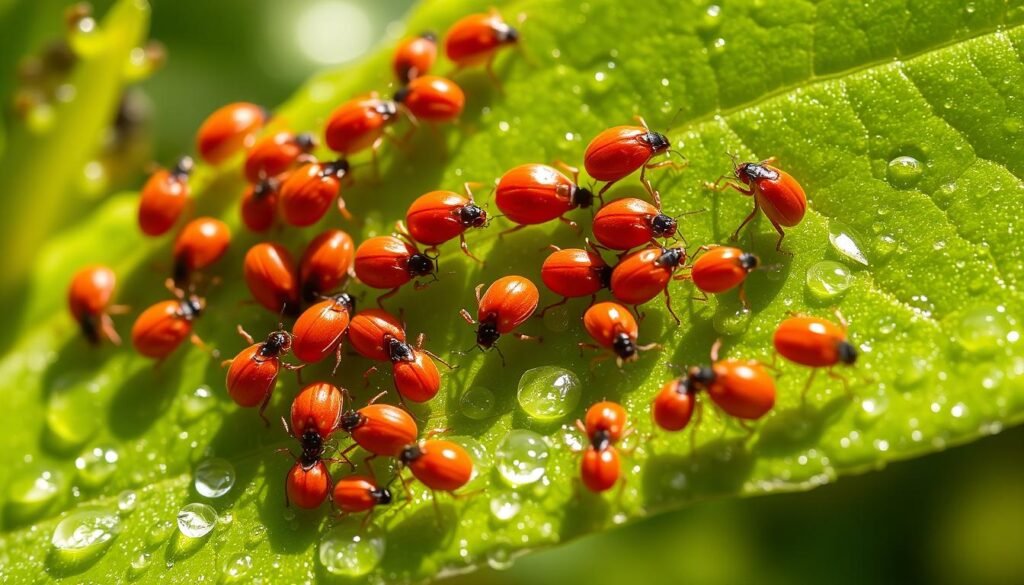Clover mites are the crimson crawlers you might spot at home. These tiny arachnids look alarming but are harmless nuisance pests. They’re related to spiders, scorpions, and ticks.
Clover mites don’t feed on humans or pets. They don’t bite either. Their bright red color comes from their biology, not from drinking blood.
These ruby-tinted bugs love fertilized lawns and sunny spots. They munch on grass, plants, weeds, and clovers. Clover mites can sneak through tiny cracks in your home’s foundation.
Table of Contents
ToggleKey Takeaways
- Clover mites are tiny, red-colored arachnids, not insects.
- They do not bite or pose any health risks to humans or pets.
- Clover mites are drawn to lush, fertilized lawns and sunny areas.
- These pests can easily find their way inside homes through cracks and crevices.
- Clover mites are considered a nuisance pest, as they can leave red stains when crushed.
What are Little Red Bugs?
Those tiny, red bugs around your home are likely clover mites. These miniature scarlet arthropods are related to spiders and ticks. They’re no larger than a ballpoint pen’s head and classified as “minute arachnids”.
Identifying Clover Mites
Clover mites pose no threat to humans or pets, despite their alarming color. Their ruby tint comes from their biology, not from feeding on blood. These tiny bugs are harmless and don’t bite people.
Clover mites eat plant material, making them more of a nuisance than a danger. They’re among the smallest home invaders, slightly smaller than a pinhead and about 1mm in size.
Their compact size makes them hard to spot alone. But when they gather in large numbers, you’ll notice them easily. Clover mites can quickly grow to thousands under good conditions.
They’re common in and around homes, especially during spring and fall. People often mistake them for more harmful pests due to their size and color.
| Characteristic | Clover Mites | Chiggers | Red Velvet Mites |
|---|---|---|---|
| Size | Slightly smaller than a pinhead, around 1mm | Less than half the size of clover mites, invisible to the naked eye | Noticeably bigger than clover mites and chiggers, 1-3mm |
| Habitat | Invade structures in large numbers, especially active in spring and fall | Parasites on humans and other vertebrate animals | Predators on small arthropods |
| Impact | Harmless nuisance pests | Can cause itching for 1-2 days | Beneficial as predators |
Little Red Bugs: Harmless Nuisance Pests
Tiny red bugs, also known as clover mites, are harmless nuisance pests. They don’t damage homes or spread diseases. Their only issue is leaving red stains if crushed.
Clover mites can be annoying despite their small size. Female mites lay up to 70 eggs, which mature in 30 days or less. Only female clover mites live in the United States.
These mites reproduce quickly, making them hard to manage. If you see one, there are likely more nearby.
Clover mites gather in large numbers, especially in sunny spots. Thousands may huddle on a building’s siding or porch. Their tiny size makes them hard to spot.
They can enter homes through small cracks. Creating a gravel barrier around your home can help reduce mite occurrences.
For large infestations, professional help is recommended. Over-the-counter pesticides may not work effectively. Pest control companies use EPA-registered products to eliminate clover mites.
In summary, clover mites are harmless but annoying pests. With the right approach, they can be effectively managed.
Why Do I Have Little Red Bugs?
Attractants and Entry Points
Tiny red bugs love heavily fertilized lawns. These miniature scarlet arthropods feast on grass, plants, weeds, and clovers. They often gather in large groups on the sunny side of house foundations.
These petite ruby-tinted bugs can squeeze through small cracks around your home. They enter through gaps near windows, doors, and the foundation. Poor lawn-to-foundation separation makes it easy for these pests to invade.
| Clover Mite Facts | Statistics |
|---|---|
| Size | Approximately 1/30th of an inch long |
| Behavior | Do not bite, sting, or transmit diseases |
| Lifecycle | A few weeks, with many generations annually |
| Control | Experienced exterminators can provide targeted insecticide treatments |
Prevent clover mite infestations by maintaining proper landscaping around your home. Seal all potential entry points to keep these pests out. These steps will help keep diminutive vermilion crawlers from invading your space.
Little Red Bugs: Reproduction and Lifecycle
Clover mites are tiny, ruby-colored creatures with a fascinating reproductive process. These resilient bugs use parthenogenesis, where females lay eggs without males. Their unique ability allows them to multiply quickly and form large infestations.
A single female can produce up to 70 eggs at once. These eggs mature in just 30 days or less. In the United States, only female clover mites exist, ensuring rapid population growth.
| Lifecycle Stages | Duration |
|---|---|
| Egg to Adult | 30 days or less |
| Generations per Year | Up to 6 |
| Eggs Laid per Female | Approximately 70 |
Clover mites prefer warm environments between 75°F and 102°F. This temperature sensitivity explains their rapid spread during warmer months. Their quick reproductive cycle contributes to their potential as a household nuisance.
“Clover mites are parthenogenetic, meaning the females can lay eggs without the need for males, allowing them to reproduce rapidly and efficiently.”
Learning about these minuscule carmine creepy-crawlies is crucial for effective management. Understanding their lifecycle helps prevent infestations of these small ruby-colored creatures. Knowledge is key to controlling these compact cardinal critters.
Preventing Little Red Bug Infestations
Exclusion and Lawn Maintenance
Seal cracks around your home’s foundation to keep tiny red bugs away. Create a barrier with gravel or stone between your lawn and house. Avoid over-fertilizing your lawn, as these bugs love lush environments.
Female clover mites can lay up to 70 eggs at once. They mature in just 30 days or less. Indoors, these tiny insects live for 1-2 weeks.
Proper exclusion and lawn care are vital to prevent infestations. Without the right steps, these pests can quickly establish a stronghold in your home.
- Keep a 2-foot strip around the home’s perimeter free of vegetation to prevent clover mite entry
- Ensure weather stripping on windows and doors is in good condition to block access points
- Avoid over-fertilizing the lawn, as lush vegetation can attract these diminutive pests
- Seal any cracks and crevices around the foundation to create a barrier against tiny red bugs
Take action to protect your property from these nuisance pests. By following these steps, you can keep your home free from tiny red bugs.

Controlling Little Red Bugs
Clover mites are tiny red bugs that can invade homes. These 1/64-inch creatures slip through cracks easily. Regular pesticides often fail to eliminate them effectively.
Professional pest control services like My Pest Pros offer the best solution. Their experts use specialized products to tackle these pests. They can identify entry points and treat both interior and exterior areas.
Quick action is crucial when dealing with clover mites. These bugs enter from outside but don’t breed indoors. Professionals target the foundation and surrounding areas to reduce mite numbers rapidly.
Avoid crushing these bugs as they leave stubborn stains. Use a vacuum cleaner to remove them safely. Professional help ensures proper pesticide application and effective elimination.
Clover mites typically invade during cool spring and fall weather. They’re attracted to well-watered grass and plants. Keep your lawn short and well-maintained to deter these pests.
Seal cracks around your home to prevent entry. Combine professional pest control with prevention for the best results. This approach helps keep these tiny red bugs away effectively.
Little Red Bugs: Staining and Cleanup
Tiny red bugs can leave unsightly stains on walls, carpets, and furniture. These bugs have pigment-rich bodies that easily transfer to surfaces. This creates stubborn, unattractive marks that are hard to remove.
Avoid crushing these petite pests at all costs. Squishing them will only spread the stain and make cleanup harder. Instead, gently remove them using a vacuum or damp cloth.
Wiping or scrubbing the stains can make things worse. The coloring can set into the material, making it even more difficult to clean.
| Stain Removal Tips | Recommended Actions |
|---|---|
| Avoid crushing the bugs | Use a vacuum or damp cloth to gently remove them |
| Don’t wipe or scrub the stains | This can set the stain and make it harder to remove |
| Act quickly to clean up the stains | The sooner you address the issue, the easier it will be to remove the stains |
Follow these steps to manage staining issues caused by diminutive vermilion crawlers. Keep your home clean and free from unsightly marks. Take action to control these bugs and avoid dealing with stains.

The Resilience of Little Red Bugs
Clover mites are tiny red pests that can be tough to get rid of. They’re only about a millimeter in size, making it easy for them to slip through small cracks. These bugs can multiply quickly, leading to big infestations.
When crushed, clover mites leave behind stubborn red stains. This makes them even more of a nuisance. But don’t worry! There are ways to deal with these pesky critters.
Professional pest control and prevention methods can help manage these tiny red invaders. Exclusion techniques and proper lawn care are effective strategies.
Overcoming Challenges
You can fight back against clover mites with some simple steps. Sealing entry points can keep them out of your home. A well-maintained lawn and garden reduces their habitat.
Here are some helpful tips:
- Regularly inspect and seal cracks and crevices in the home’s exterior
- Keep the lawn mowed and free of tall grass and weeds
- Prune and maintain landscaping to minimize potential hiding spots
- Consult with a professional pest control service for effective elimination strategies
Taking action and getting expert help can solve your clover mite problem. You can reclaim your home from these tiny red invaders. With the right approach, you’ll be bug-free in no time.
Seasonal Patterns of Little Red Bugs
Clover mites thrive in mild spring and fall weather. Females lay bright red eggs in dry, protected spots. As eggs hatch, clone-like offspring emerge, causing a rapid population increase.
These tiny red bugs often gather on sunny home sides and lawns. They require proactive management during peak seasons. Clover mites measure about 1/30 inch, smaller than a pinhead.
Adult mites are dark brown, while young ones and eggs are bright red. They feed on over 200 plant types, with clover being a favorite. Eggs hatch into larvae during warm weather.
After several molts, clover mites become adults in about a month. They’re mainly outdoor pests but can enter homes in large numbers. These tiny crawlers don’t harm humans or pets.
| Characteristic | Description |
|---|---|
| Size | Approximately 1/30 of an inch in length, smaller than a pinhead |
| Color | Bright red for young mites and eggs, darker brown for adults |
| Feeding Habits | Feed on sap from over 200 different plant types, including clover |
| Life Cycle | Hatch from eggs during warmer weather, mature into adults in about a month |
| Habitat | Primarily outdoor pests, but can enter homes in large numbers during spring and fall |
| Threat | Do not pose any danger to humans or pets, as they do not bite, sting, or transmit diseases |
Clover mite numbers drop as weather warms in late spring. They lay eggs and become dormant until the following spring. If crushed, these bugs leave red stains on light-colored surfaces.
Conclusion
Seeing little red bugs or tiny crimson insects at home can be unsettling. However, these miniature scarlet arthropods are harmless clover mites. They don’t bite, spread diseases, or damage structures. Their red color comes from their biology.
To prevent clover mite infestations, seal entry points and maintain your lawn. Consider professional pest control if needed. Understanding these creatures helps homeowners keep diminutive vermilion crawlers away.
By taking the right steps, you can enjoy outdoor spaces without these minuscule carmine creepy-crawlies. Remember, petite ruby-tinted bugs are just a nuisance, not a threat. With proper management, you can keep your home free of small ruby-colored creatures.
FAQ
What are the little red bugs in my home?
The tiny red bugs in your home are clover mites. These minute arachnids are related to spiders, scorpions, and ticks.
Are clover mites harmful?
Clover mites are harmless nuisance pests. They don’t feed on humans or pets, and they don’t bite. Their bright red color comes from their biological makeup.
Why do I have clover mites in my home?
Clover mites love heavily fertilized lawns and sunny sides of homes. They feed on grass, plants, weeds, and clovers. These tiny pests can easily slip through small cracks to get inside.
How do clover mites reproduce?
Clover mites reproduce through parthenogenesis. Females lay eggs without help from males. A single female can lay up to 70 eggs.
These eggs can mature in just 30 days or less.
How can I prevent and control clover mite infestations?
To prevent clover mites, seal cracks and create a barrier between lawn and foundation. Avoid over-fertilizing your lawn. For control, professional pest services are often the best solution.
They have specialized products and techniques to handle infestations effectively.
How do I clean up clover mite stains?
Avoid crushing clover mites, as their bodies can leave hard-to-remove red stains. Use a vacuum or damp cloth to gently remove them instead.
Why are clover mites such resilient pests?
Clover mites are tough due to their small size and unique reproduction. They can slip through tiny cracks easily. Their parthenogenetic reproduction allows for rapid population growth.
When are clover mites most prevalent?
Clover mites thrive during spring and fall when the weather is milder. Females lay bright red eggs in protected cracks and crevices during these seasons.

